Care Home Data Review Summary Report
The Care Home Data Review (CHDR) is a multi-agency (Scottish Government, Public Health Scotland, and Care Inspectorate) review of the national data landscape relating to care homes for adults.
Key Themes and Recommendations
A brief summary of feedback and the recommendations from the review are shown below. The recommendations are shown against the key themes raised in the review and are presented alongside the intended aims.
The recommendations range from those that could be achieved in the short term to medium term, for example the setting up of data provider/user networks and increasing the transparency of data collections, to more complicated actions likely to take a number of years to complete, for example potentially establishing a core minimum dataset for care home data.
Theme: Strategic Oversight
A common request across the engagement was for greater strategic oversight and co-ordination of data collections, analysis and outputs.
There are a large number of data improvement / development projects being undertaken both within and across organisations interested in care home data. This work needs to be considered in the context of the much wider programme of work across health and social care to deliver the Data Strategy for Health and Social Care. The development and delivery of the Data Strategy is overseen and governed by the Health and Social Care Data Board, supported by two sub-boards: the Data Delivery Sub-board and the Data Standards Sub-board.
In addition, during the course of the review, the Social Care Data and Intelligence Programme Board (SCDIPB) was set up to support and optimise the development and analysis of social care data. This new governance structure will provide greater strategic oversight, should help reduce duplication and improve co-ordination by ensuring an overarching programme approach is undertaken, given the number of teams and organisations currently working on social care data and analysis.
Feedback to the review highlighted the lack of over-arching data provider / user networks for care home data. Establishing networks between providers of care home data, producers of statistics / information and data users should help the development of key data questions, inform the best way to communicate findings and provide a route for feedback from users of data outputs/analysis. Provider networks could act as a forum through which national agencies could provide clarity on data collections (guidance, timetables, rationale) and also where local area providers could speak to their counterparts in other areas to discuss data issues / ask for assistance. Importantly, they would also allow providers to input into how best to meet particular data demands and reduce the chance of misinterpretation of requests.
Aims and recommendations relating to Strategic Oversight theme
Aims: Ensure strategic oversight of the large number of data collections / projects in the care home data space, and work to tie these together to improve coherence and reduce duplication.
Recommendations
Widely publicise the existence & Terms of Reference of Social Care Data & Intelligence Programme Board (SCDIPB), to ensure transparency in oversight.
Develop a multi-agency data plan to embed joint priorities across organisations, agree roles and responsibilities and how we collaborate on stakeholder engagement.
Aims: Improve knowledge exchange between the care home sector and the care home analytical community and ensure the care home sector has a voice with regards to national data collections and corresponding outputs.
Recommendations
Establish data providers network to help shape data collections, agree definitions, share good practice and improve data quality.
Establish data user network to help develop key data questions, inform best way to communicate findings and provide a route for feedback from users on data outputs. In addition, investigate alternative ways of engaging / collaborating with the wider sector.
Aims: Streamline and coordinate the process for approving new national data collections to limit duplication and ensure data requested is fit for purpose.
Recommendations
Put in place governance structure and agree a process for approving new national data collections to limit duplication.
Theme: Data Rationalisation
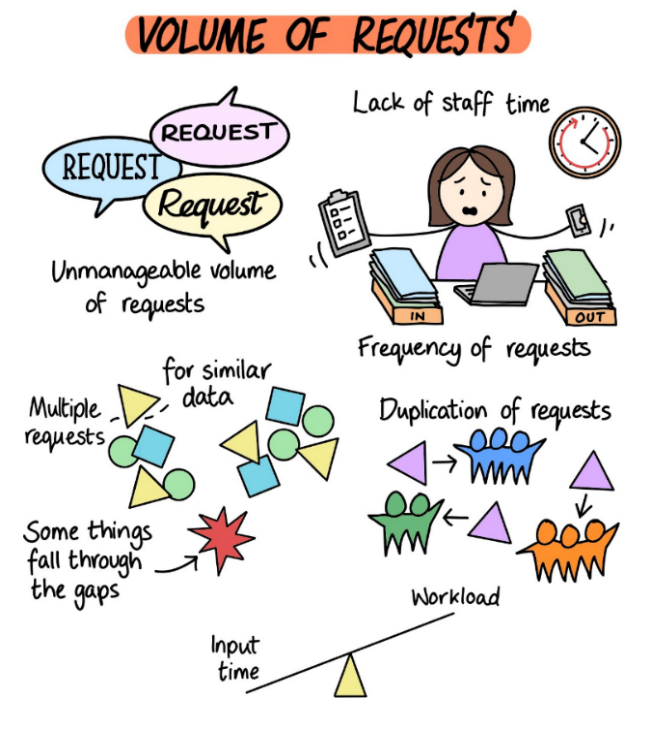
A key issue highlighted in discussions with data providers was the sheer volume of requests for data, along with limited staff resource to dedicate to data collection. In order to better understand the scale, size and scope of data collected, one of the first stages of the review was to undertake a mapping of all the current requests for care home data, at national level. Further information on the current national collections of care home data is available on the Care Home Data Review webpage.
To ensure we are collecting the right information, it is essential that we have a clear understanding of the data needs across the sector. We need to be clear about what data are required, by whom, by when and for what purpose. These needs will vary both by use and by the person / organisation using the data (e.g. care home staff, Local Authority (LA)/Health and Social Care Partnership (HSCP), central government). We need to ensure any rationalised set of data collections still meets the needs of the variety of data users. Data rationalisation will also require agreement on data definitions / standardisation and data sharing (see section on Data Sharing for more information).
Another option raised repeatedly in the review was the establishment of a core minimum data set (CMDS) for care home data, such as the staff CMDS maintained by Scottish Social Services Council (SSSC). This would require agreement of a commonly defined set of key data items for collection. The Care Home Data Working Group will look to determine the feasibility of establishing a CMDS.
Aims and recommendations relating to Data Rationalisation theme
Aims: Work with the sector to clearly articulate data needs and data flows to meet these needs.
Recommendations
Continue to develop a detailed map of data needs and reporting requirements, purpose of data and frequency required. For example, equalities data, regulatory data requirements, and emerging needs for the Healthcare Framework and National Care Service.
Aims: Rationalise and align collections against data need and improve coherence between data collections across organisations, where possible considering local collections.
Recommendations
Set up working group(s) / workstream(s) to investigate areas for rationalisation and where data collections/variables can be removed, due to lack of use / quality or duplication. Including:
- Consider options for the Care Home Census by reviewing data requirements and assessing if this data can be extracted from alternative sources, such as Source Social Care returns, Care Inspectorate data and Turas Care Management data collection.
- Consider opportunity to stop SG Free Personal Nursing Care data collection and the potential to incorporate into the PHS Source Social Care data collection. Producing options paper on what are the challenges, how/if they can be overcome and in what timescale.
- Consider potential to re-purpose data collected for regulatory / statutory purposes. For example, look at how data collected by Care Inspectorate compares to Turas Care Management data collection.
- Following rationalisation of the (previous) Safety Huddle Tool (SHT) return, now Turas Care Management (TCM) Data Collection, continue sector engagement to ensure continued relevance.
Aims: Look to establish a core minimum dataset that can be easily accessed and used by all those who need to use it.
Recommendations
Set up working group to determine the feasibility of establishing a core minimum dataset to meet the needs of those who need to use care home data for planning, service delivery, surveillance, regulation, policy development and research purposes.
Theme: Data Gaps
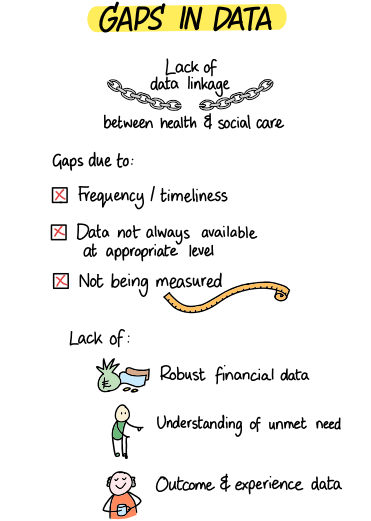
It is widely acknowledged that there are a number of gaps around care home data and evidence in Scotland. The Covid-19 pandemic highlighted some fundamental gaps, particularly around being able to identify the care home population. Other areas highlighted during the care home data review include: data on outcomes and wellbeing, care and support experiences, the role of care homes for providing different types of care, and the complexity and dependency of care home residents. Further information on identified data gaps are contained in the previously published summary of workshop discussions.
A common theme identified during the review was the need for better and more timely data about the care home population, including the needs of care home residents. In addition, national and local organisations require data to enable monitoring and evaluation of outcomes, quality, improvement and safety.
In general, whilst it is recognised a large amount of data already exists, the areas highlighted for development are:
Care home residents –It is essential to understand who care home residents are, along with the composition and needs of the resident population. Need to understand the complexity of care.
Care home workforce – there is a need for more timely and accurate data on staff recruitment, turnover and retention, to determine safe staffing levels to meet the needs of residents.
Care homes & services – real time data on care home capacity (by bed type), occupancy rates, bed vacancies and discharges. Better data on outbreaks (covid, flu, norovirus etc) and visiting information.
Care home finance – need robust financial information relating to care homes, including types of funding, who is on what contract rate and details for charges to self-funders.
In some cases, the gaps are caused by non-recording of a data item. However, at times the quality and timeliness of existing data can lead to a reduction in its usefulness or in it not being used at all, creating a gap.
There is an identified need to work with care home data users and providers to look at new and innovative ways of addressing data gaps. This also links to rationalisation, in that a key factor is an understanding of the data requirements, for a potentially large number of needs.
Aims and recommendations relating to Data Gaps theme
Aims: Work with the care home sector and data users to prioritise and identify how best to address our data gaps.
Recommendations: Having identified data requirements and compared to the current data landscape, work with data users to prioritise gaps. A number of key areas were raised during the review, examples include "Workforce, recruitment, turnover & retention ", “Outcomes & Experience" and " Resident population & needs data".
Aims: Make better use of techniques and technology, such as data linkage, and collaborate to share data to address data gaps.
Recommendations: Explore and develop case studies on success of alternative methods for improving quality / addressing data gaps. For example, using Unique Property Reference Number (UPRN) data to improve data availability and reduce need for multiple collection.
Theme: Data Quality, Insight and Relevance
Data quality, timeliness and the value of information were themes that were raised as part of the review.
Lack of Insight

Concerns were expressed about the coherence of, and insight from, both the data collected and subsequent analysis. Concerns include:
Finding and accessing data
- data are held in multiple locations and can be challenging to find and access.
- not all data and analysis that could be publicly available is made available for public accountability.
Problems understanding & interpreting data
- multiple data sources on similar topics but not necessarily showing consistent information.
- lack of narrative to aid understanding of what the data can be used for and/or what the data are telling us.
- due to variations in the complexity of care, simple comparisons can be misleading.
Lack of resources
- gaps in our data and research infrastructure.
- having the resources (e.g. financial, skills, software, capacity, knowledge) to maximise use of care home data.
Quality and completeness of existing data
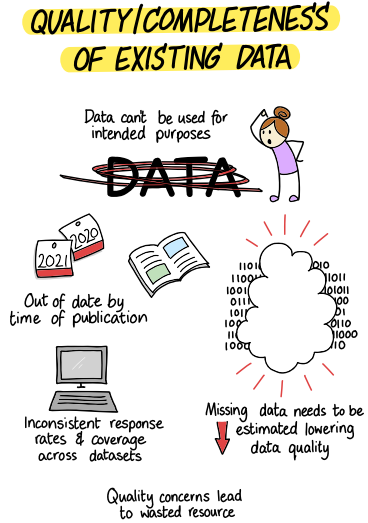
Data users told us about issues with the quality, timeliness and completeness of care home data. Issues included:
Quality/completeness of data
- existing data not providing answers to fundamental questions about care homes, residents and staff.
- data not currently available at the level of detail required or in the appropriate timeframe to maximise impact.
- incomplete/inconsistent coverage – issues caused by different methods and/or ability of care homes to complete certain data collections.
Inconsistent data/unfit for purpose
- variation in response rates across different collections and, in particular, very low response rates for some variables, significantly reducing usefulness e.g. expenditure information.
- inconsistent data definitions / uncertainty in what is being asked for, leading to inconsistent data returns across datasets impacting on the usefulness of the data.
Out of date data
- depending on use, data may be out of date by time of publication.
- systems do not contain most up to date data.
There is a clearly identified need to improve the quality and timeliness of data, make data more accessible, and improve contextual information to help aid interpretation and understanding of what the data are telling us. Where data are of poor quality, national organisations producing care home statistics need to work with care home data providers to understand the potential difficulties with data provision and either work to improve the data, collect through a different method or stop collection. An important aspect to improving insight will be for data producers to work with care home data users to understand and agree the key questions that need to be answered.
Aims and recommendations relating to Data Quality, Insight and Relevance theme
Aims: Improve the findability and accessibility of information about data collections, analysis and publications.
Recommendations
Bring together and publish information on care home data collected by national bodies in a central data catalogue. This will contain variable level data and show basic information (or metadata) about each data collection, such as its purpose, frequency and provide information on the benefits of the data collection.
Data producers to make available metadata for published datasets and share on open data platforms (e.g. Statistics.gov.scot) to increase visibility of care home data.
Aims: To work with the Care Sector to ensure that all data collections are timely, accurate and add value.
Recommendations
Data producers for national data collections to undertake a variable-level review of quality and completeness for each data source, and work with the care home sector to improve or stop the collection of data known to be of poor quality.
Data producers to consider the timeliness of data outputs and the potential to release less validated data as provisional outputs, if considered useful and not misleading.
Aims: Ensure we help readers to understand the key insights being derived from the analysis of data.
Recommendations
Data producers to use data users networks and other means to review products / outputs for the main data collections and ensure analysis is presented in a way that meets the needs of different data uses.
Data producers to work together to improve the coherence of published care home data in line with Office of Statistics Regulations (OSR) recommendations.
Aims: Work to increase trust in our statistics.
Recommendations
Data Producers to adhere to principles of the Code of Practice for Statistics for our key national data collections and publications.
Investigate the potential to use data linkage to improve data quality and insights (e.g. linkage of Scottish Care Home Census to National Records of Scotland’s deaths data).
Aims: Work with the wider sector to improve local context and improve insight and quality from data
Recommendations
Work with local partners to help share good practice and to provide additional support around making data collections more efficient, providing additional analysis and support for interpretating analysis.
Where appropriate, work with the research and innovation sector to improve insight & data quality.
Theme: Communications
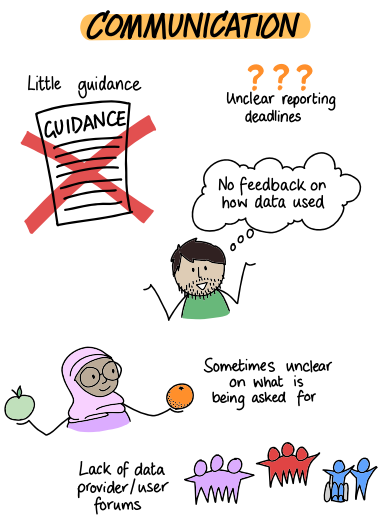
A strong theme to emerge from the Care Home Data Review (CHDR) was communication. Particular challenges raised included the need to improve the guidance and support for providing data. Data providers noted that some definitions and recording guidance lack clarity, therefore providers interpret what data are being requested differently.
This impacts on both the burden of provision of data and the usefulness of the data provided. In addition, it was noted that improved communication around data collection timetables or sign posting where these are available would be beneficial and allow better planning.
Further communication challenges were raised around the lack of feedback on why data are collected or how it is used. Care Homes and Health and Social Care Partnerships often felt they were providing data into a ‘black hole’, with providers unclear about where and how this data were being used to benefit those living and working in care homes. We need to work to ensure that data providers are clear of the benefits of data provision.
Ways of communicating with data users, to improve accessibility, understanding & insight from data are covered under the Data quality, Insight and Relevance section.
Aims and recommendations relating to Communications theme
Aims: Improve advance notice of collections, guidance notes and documentation relating to data collections.
Recommendations
Create data collection and publication plans that bring together relevant national care home data collection documentation and provide data providers the timetable for all routine data collections throughout the coming year.
Aims: Demonstrate the benefits of care home data (build understanding, inform decision making etc).
Recommendations
Care home analytical community to articulate and share the benefits of care home data with stakeholders, for example, through the data user networks, contributing to Care Inspectorate newsletters, inclusion in an annual letter to data providers from SG.
Aims: Improve knowledge exchange between the care home sector and the care home analytical community and ensure the care home sector has a voice with regards to national data collections, and corresponding outputs.
Recommendations
CHDR partners to work with data provider network to both inform the content and frequency of data collections and consider the desired outputs to be shared back with the sector.
Use data user networks to discuss current outputs and what changes could be made (short, medium & long term). Ensure data outputs meet the needs of as wide a range of stakeholders / uses as possible and improve the understanding of, and outcomes for, people living in care homes.
Theme: Data Sharing
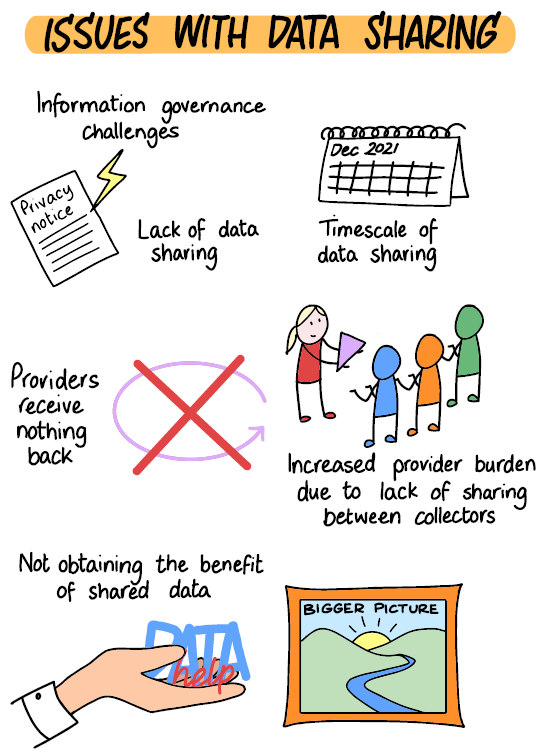
Feedback from the Care Home Data Review was clear that, while some data sharing does exist, we are not currently fully benefitting from the potential for data sharing across organisations. The lack of sharing between data producers has led to multiple data collections, leading to a confusing data landscape and increased burden on data providers. Data providers noted that they were not always receiving information back so do not fully realise the potential benefits of data provision – which de-incentivises provision. A lack of data sharing was also seen as a barrier to the ability to provide relevant and timely analysis for the development and monitoring of policy and legislation.
The data landscape around care homes is complex, with a large number of care homes supplying data to various local and national organisations, for many different purposes. This complexity can lead to a number of challenges for data sharing as current data sharing arrangements may not provide for onward sharing or repurposing of data. There is a need to ensure that any data sharing is legal, appropriate and secure, to ensure that the privacy of individuals is protected.
It was also flagged during the review that data sharing could help to utilise the full analytical capacity of the sector and maximise the potential benefits for those living and working in care homes. Allowing safe access to care home data to the research and innovation sector would also help increase analytical capacity, evidence and expertise to inform policy and practice, to ultimately improve care.
Work on sharing care home data will form one part of wider work to implement the aims and commitments for protecting and sharing data outlined in the Data Strategy for Health and Social Care.
Aims and recommendations relating to Data Sharing theme
Aims: We will work to agree and publish a plan to share data securely and efficiently.
Recommendations
CHDR partners will establish a Data Sharing Working Group, containing both information governance and data professionals, to progress the safe sharing of care home data across organisations, where appropriate. The first task of the group will be to consider short, medium and long term opportunities.
Working Group will engage with stakeholders and manage barriers and risks associated with data sharing, and publish / advertise more widely the benefits of, data sharing. Produce documentation about how we improve sharing in social care, and how we do it safely and responsibly.
Ensure the Working Group links into the National Information Governance Plan for Health and Social Care.
Aims: Work to share added-value data and analysis back to data providers to maximise benefits of data provision.
Recommendations
Work with stakeholders to understand what data providers would find beneficial to have and take forward as a workstream of the Data Sharing Working Group.
Aims: Establish and publish a timely and efficient approvals process for accessing care home data for research.
Recommendations
Work with the Public Benefit and Privacy Panel for Health and Social Care (PBPP) and Research Data Scotland (RDS)/Administrative Data Research (ADR) to facilitate sharing of data for research with appropriate information governance in place.
Theme: Data Systems and Standardisation
Data Systems / Processes

Due to the mixed nature of care home provision, with public, private and voluntary / not for profit providers, there are a wide range of systems and processes used to generate, capture and record data. These range from paper-based records to a variety of different electronic Management Information Systems (MIS). Similarly, there are a range of different systems and processes used within local authorities to generate data. Feedback from the review suggested that, in many cases, the information requested for local and national purposes is difficult to extract and provide in the required format. This is exacerbated by multiple requests asking for similar, but subtly different, information. The lack of consistent data requests means that data providers have to provide multiple datasets to different groups, through different systems - increasing workload and frustration.
There is currently a large programme of work being taken forward to improve digital infrastructure to better collect, store and use data, as part of the Digital Health and Care Strategy.
Standardisation

As noted previously, the care home data landscape is complicated by having a large number of different organisations involved in the provision of care, using different systems and standards and with differences in data maturity across local areas. The lack of standardisation and harmonisation can lead to inconsistent data to inform decisions, reduce comparability and interoperability, increase the data collection burden, and make it difficult to reuse data. It was noted in the review that data standardisation, and sharing, are also critical to rationalising the current data landscape.
As with the development of system solutions, the work to establish common data standards for care home data will be only one part of much wider work ongoing to develop data standards across the whole of health and social care.
Aims and recommendations relating to Data Systems and Standardisation theme
Aims: Improve data systems and interoperability
Recommendations
Link in with the wider work on improving data infrastructure and interoperability as part of the Digital Health and Care Strategy.
Work with local government partners to explore alignment of work on care home data to the Local Government Data Platform project.
Continue to explore existing systems and real-life care home data capture in order to better understand and inform required improvements.
Aims: Agree consistent standards and definitions for use across care home data collections.
Recommendations
Link in with the work of the Data Standards Sub-board for health and social care.
Investigate the potential for national data collections to align with appropriate standards set by work being led by Scottish Government, working with relevant stakeholders.
Scope out the work required and the potential for data producers to ensure national care home data collections, and national datasets which have a care home flag / code, use the Care Inspectorate care home definition and unique identifiers to ensure consistency, and enable data linkage, across datasets.
Theme: Ethical approach to using care home data
The Data Strategy for Health and Social Care sets out the ethical approach to using all health and social care data in Scotland. The Strategy states that “we want to embed an ethical, open, and human rights-based approach to the use of health and social care data in Scotland which maintains public trust and confidence”. The Strategy outlines the principles for the collection and use of health and social care data.
The data that is generated through the delivery of social care provides a wealth of opportunities for research and innovation. Research and innovation can improve our understanding of care and support needs; the delivery of care and support; the development of new services; progress towards reducing inequalities of access, experiences and outcomes. However, these opportunities can only be realised if there are clear and timely information governance and ethical routes for accessing and using data appropriately.
Collecting, analysing or linking data can sometimes involve a degree of ethical risk, and/or involve additional burdens or intrusions exceeding those involved in providing normal care. Ethical review and oversight are crucial steps when conducting research, ensuring that studies involving people adhere to ethical standards and principles, thus protecting the rights, dignity and safety of those involved.
In Scotland, the ethical approval processes for research involving recipients and providers of social care are often unclear and complex. Some social care research is subject to scrutiny by an NHS or a university research ethics committee. Other research organisations have no route for getting their social care research independently ethically reviewed. In some cases, the lack of infrastructure and support means that planned research will not take place in Scotland, to the detriment of users of social care, the social care sector, and the research and innovation sector.
Aims and recommendations relating to Social Care and Care Home Data Ethics theme
Aims: To embed an ethical based approach to the use of care home data in Scotland which maintains public trust and confidence.
Recommendations
Scottish Government (SG) to establish a social care ethics working group comprising representation from a range of national and local organisations, care homes, residents and other social care service users to take forward the following:
i. Building on the GEARED UP project, map the current ethical review routes for using social care data / undertaking social care research to identify gaps and inconsistencies.
ii. Produce recommendations for addressing gaps in the social care research ethics infrastructure in Scotland.
iii. Consider how social care can be represented on Research Ethics Committees (RECs) / PBPP who are reviewing social care research and innovation projects.
iv. Create and publish guidance on applying social care research ethics in Scotland to support the review process for social care research and innovation by establishing a clear pathway for accessing and seeking ethical and governance approval for using care home and other social care data.
v. Align (where possible) with social care research / innovation information governance applications with the aim of achieving an efficient approvals process.
Chief Scientists Office and Digital Health & Care Division (SG) to ensure the social care research ethics programme of work is aligned to any planned SG Health & Social Care wide ethics work and SG wide ethics work.
Contact
Email: SWStat@gov.scot
There is a problem
Thanks for your feedback